Years ago, there was a time when I scribbled several draft designs imagining myself a smartwatch. One of those drafts actually had both the features of an analog and digital watch. I thought that if a smartwatch is made of a real watch with physical hands and a digital display, it could be at least a little helpful in solving the issues smartwatches currently face, such as limited battery life and being a fake watch with just a display.
Naturally, the first step of this concept is to solve the manufacturing difficulties. One of the those is the assembly of the display that is placed under the watch hands. Interestingly, smartwatch makers challenging to bring such concept into reality began to emerge and the LG Watch W7 took the title of being the latest smartwatch with both real watch hands and a display.
Although I am glad that the LG Watch W7 is a smartwatch that turned imagination into reality, I can’t say that it is the right answer to the question of whether it has all the advantages of a hybrid smartwatch. Because of that, it could be too cruel to tell the harsh reality to the LG Watch W7, a product born from imagination.
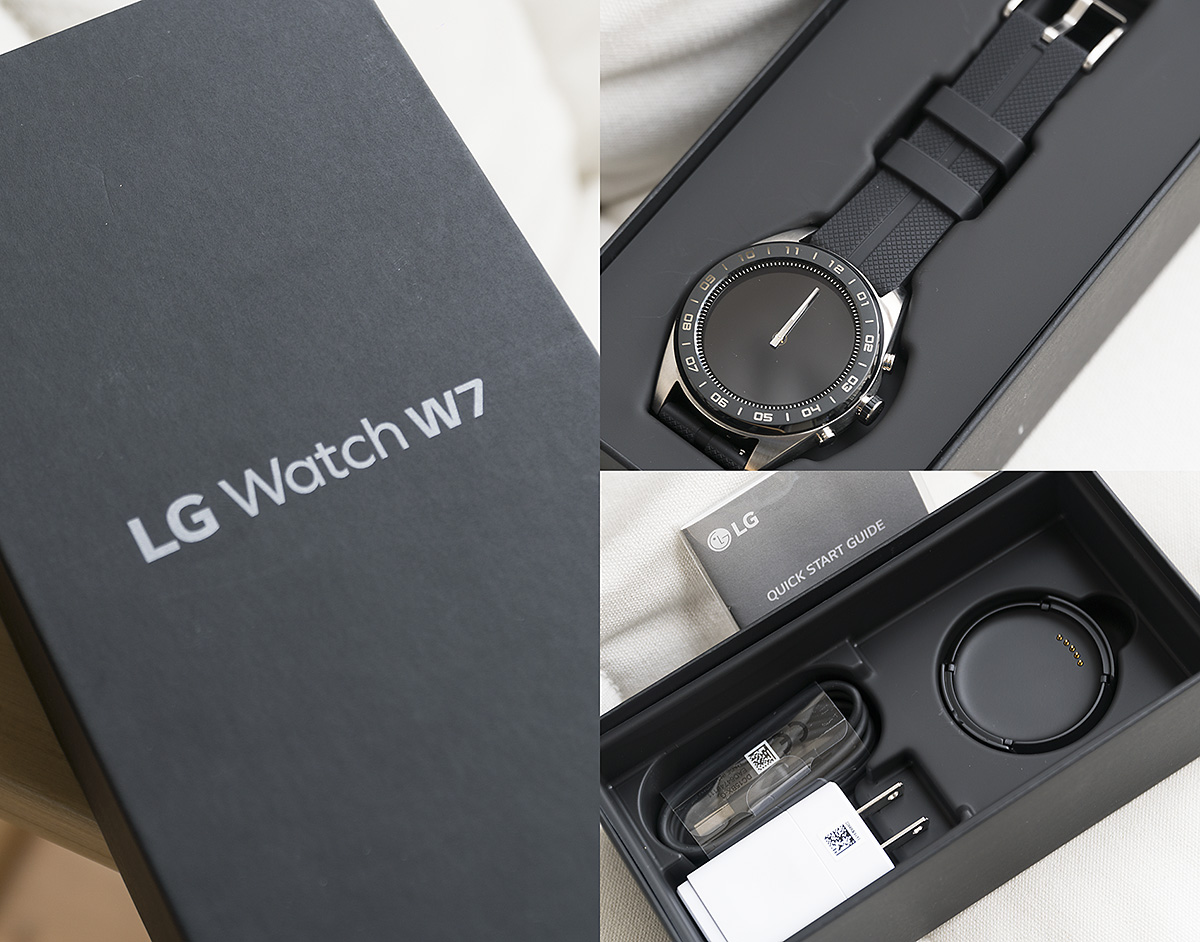
The package | I didn’t think it was a smartwatch
When I first saw the delivered black cuboid package, I got confused. When I was about to question myself of whether I’ve ordered a smartphone, the product name ‘LG Watch W7’ written in bold on the upper part of the package caught my eyes. I was once again surprised that this was a smartwatch package. The LG Watch W7 is a smartwatch selling at a price of no less than $450 in the US and ₩400,000 in Korea. But the straight cuboid package made of pressed paper does not help at all to rationalize the high price.
As I opened the box and removed the microfiber cloth, the LG Watch W7 revealed itself, laid with its strap folded in half. The first thing I noticed was nothing else but the watch hands. It was real watch hands that usually cannot be seen in ordinary smartwatches. There is a digital display under the watch hands, but one could easily believe that it is a regular watch if the display is not turned on. Not only that, the structure of having a watch bezel, a crown and two functional buttons placed on the right side of the dial and main body gives a strong image of a regular watch.
When the plastic part that holds the watch is taken out, there is the charging dock, USB cable, adapter and manual in the lower part of the box. Everything is not much different from a regular smartphone package and even the parts are exactly the same as the ones used for smartphones. The charging dock can be attached to or detached from the watch but is fixed through pins instead of magnets. The charging dock uses the USB-C cable and the charging adapter uses a regular USB port.
At first glance, the package does not seem to have any shortcomings. But unlike the package and most of the parts being black, the power adapter alone is white. Such disharmony proves that the watchmaker didn’t pay any attention to the package. Why? Maybe because the company spent too much in developing and manufacturing a smartwatch with real watch hands? I don’t know the reason yet.
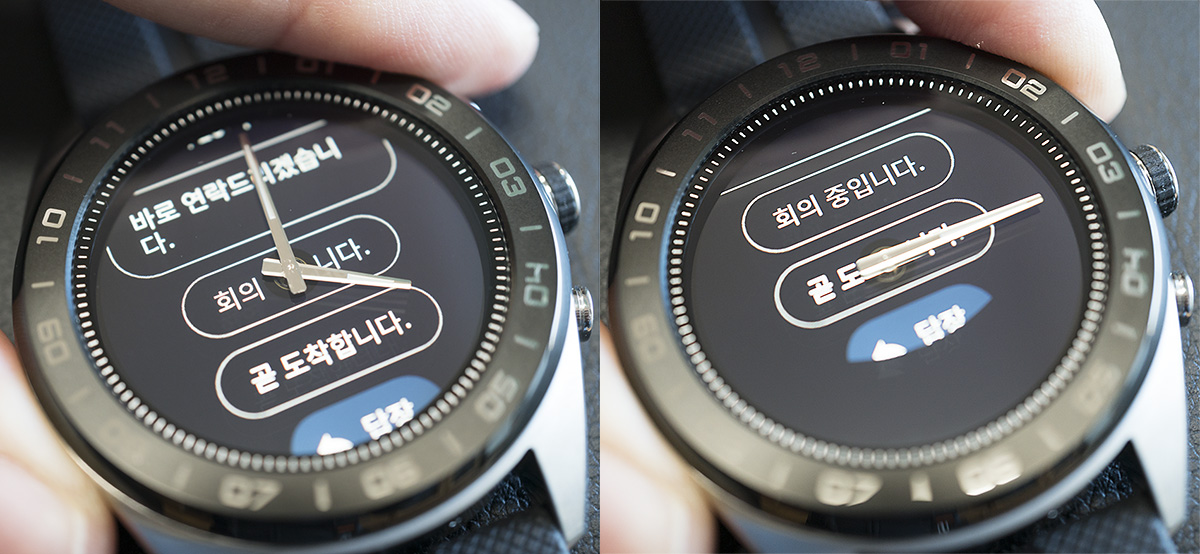
The watch hands | Not only ambiguous but also far too inconvenient
I was amazed when I pressed the power button of the LG Watch W7 because of an unusual scene. The watch hands were revolving around the watch face, matching the dynamic intro animation. After such an impressive start that cannot be experienced with other display smartwatches that usually show only the logo image and bouncing beads, it seemed that the LG Watch W7 would be different somehow.
But that was all that I liked about the watch. From the moment I selected the language for the initial setting, I started to see rather strange inconvenience. I couldn’t believe that the settings, which is the same across other Wear OS smartwatches, was much more inconvenient when using the W7. Was the screen too small? No. Was the resolution low? Not even that. The more I used the LG Watch W7, the more inconvenience that piled up just like wastes accumulating in the body. But it was not hard to find the root of such inconvenience. It was the watch hands.
What kind of an irony is it to say that a smartwatch that should promote its real hands-and-display face unlike other smartwatches, is inconvenient because of its hands? Although it helps to check the time with the display turned off thanks to the dial of the bezel and the watch hands of the LG Watch W7, inconveniences caused by the hands became more obvious.
The problem arises when the display is turned on. If I turn on the display to check the notifications, the watch hands will hide the screen. The watch hands of W7 will remain in the screen and be in the way when checking notifications or other contents. A hole in the center that connects the hour and minute hands makes it impossible to read any letters or images in that area.
LG came up with its own solution. With a press of the top button, the entire screen can be slightly pushed to the top and at the same time, the watch hands can temporarily be levelled, or the hour and minute hands can be overlapped to be less in the way. It might look like a good solution from the outside, but it’s hard to say that the W7 is more convenient than other smartwatches, when you just have to twist your wrist to check most of the contents.
Nevertheless, the watch shouldn’t be totally blamed for having applied the watch hands. It’s just that the LG Watch W7 made far too simple judgments about user experiences with the watch hands affecting the display. What if watch hands that do not affect the display were used? What if the punch hole of the display that connects the watch hands was made smaller? If the LG Watch W7 had the right answers to these two questions, I wouldn’t have had to write this paragraph.
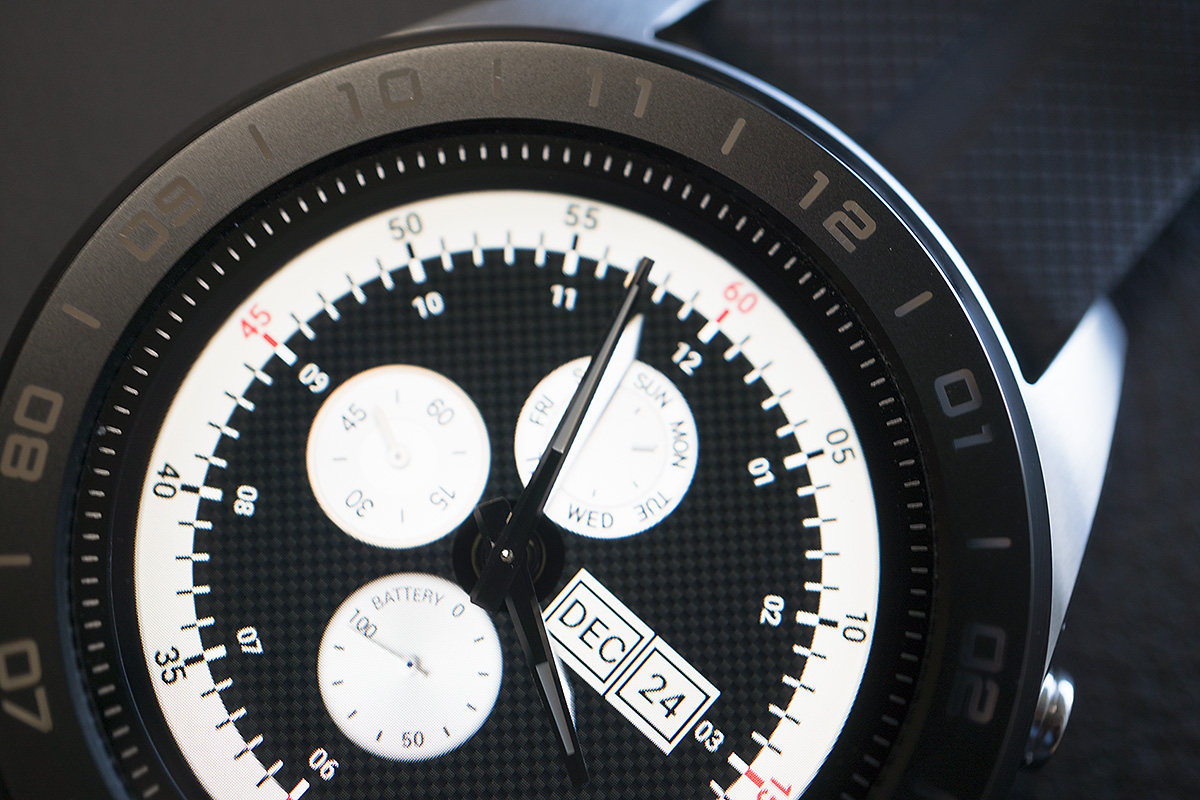
LG Watch W7’s hands in a quartz movement may not go along with the hands of the selected watch face, if they move in a mechanical movement, which has a smooth sweeping motion.
The functions | It’s not really a smartwatch, nor a regular watch
I assume that the developers of the LG Watch W7 wanted a smartwatch that can be used like a regular watch in everyday life. They must have dropped the heart rate sensor because the watch is not designed for the purpose of workout and they must have excluded even the GPS because basic location information can be received from the smartphone. They probably left out the NFC because they considered it was unnecessary to simply connect with other devices or to have pay functions. I want to believe that the developers just wanted to approach the users only as a watch and to be used as a companion device of the smartphone, rather than as a device directly connected to the network. But the compass, barometer and altimeter work fine.
It’s not that the W7 doesn’t have any smartwatch functions. Notifications are displayed, watch faces can be changed and apps can be launched by downloading from Google Play. Since the watch hands do not affect the fingers from touching the screen, it’s not a problem at all to use the existing Wear OS or apps.
Nothing has changed in the basic operation of the Wear OS, but a couple of interfaces were altered to meet the features of a device that has physical watch hands. With other Wear OS watches, apps can be launched and functions can be selected by scrolling up and down in the app screen. But the LG Watch W7 displays an app drawer that rotates around the watch dial, not to be blocked by the watch hands. Apps can be selected by touching the screen to the side. The apps will also revolve when the crown is rotated back and forth. But other than the app display, the setting display uses the same vertical scroll of the classical Wear OS instead of such interface.
Moreover, the bottom button of the LG Watch W7 gives access to the master tool, which gathers the frequently used functions. Functions such as the stopwatch, timer and compass can be launched immediately but not be replaced by other apps. Functions that can be interesting are the stopwatch and the timer. When these functions are selected, the hour and minute hands will overlap and work as a second hand. The sound of the second hand rotating can also be heard. For reference, a long press of the master mode button can black out the display and switch to watch-only mode. If the battery is charged to the fullest, the W7 can be used as a watch for 120 days without additional charging.
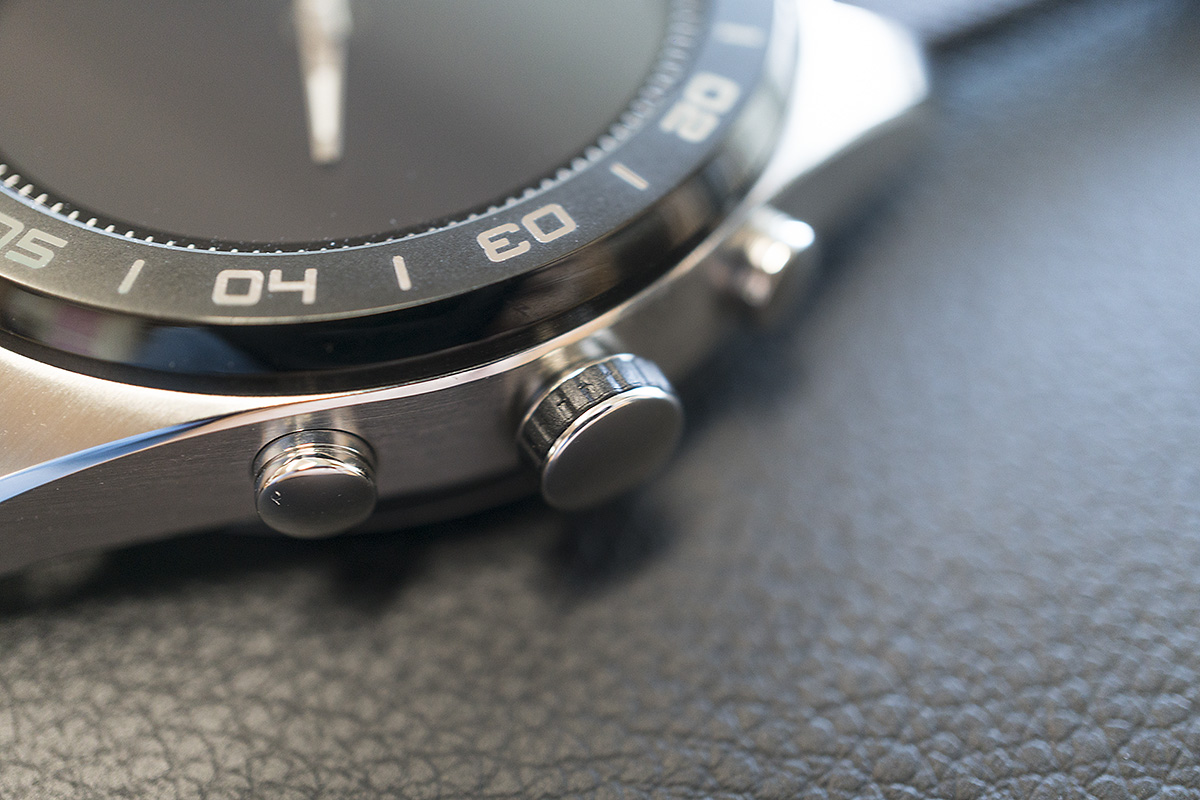
The crown can rotate back and forth just like the Apple Watch, but it doesn’t feel that good. First of all, the crown doesn’t stick out sufficiently and because the rubber area that covers the crown’s surface is too narrow, the fingers cannot have a good access and the crown will not rotate smoothly. On top of that, there are no artificial effects that imitate an actual crown and the lack of haptic feedback makes it no fun to rotate the crown.
Since the LG Watch W7 has actual watch hands, LG included ten types of basic watch faces without digital hands. Users who only use basic watch faces will not experience much inconvenience, but if a watch face with digital hands made by a third-party is applied, unexpected issues can occur. This is because the different length and width of the real watch hands and the digital hands spoil the harmony. The real hands will partially hide the digital hands and the digital hands with a wide width will stick out of the real hands, looking ugly. Considering all these unexpected problems, the W7 is definitely a smartwatch that goes far beyond imagination.
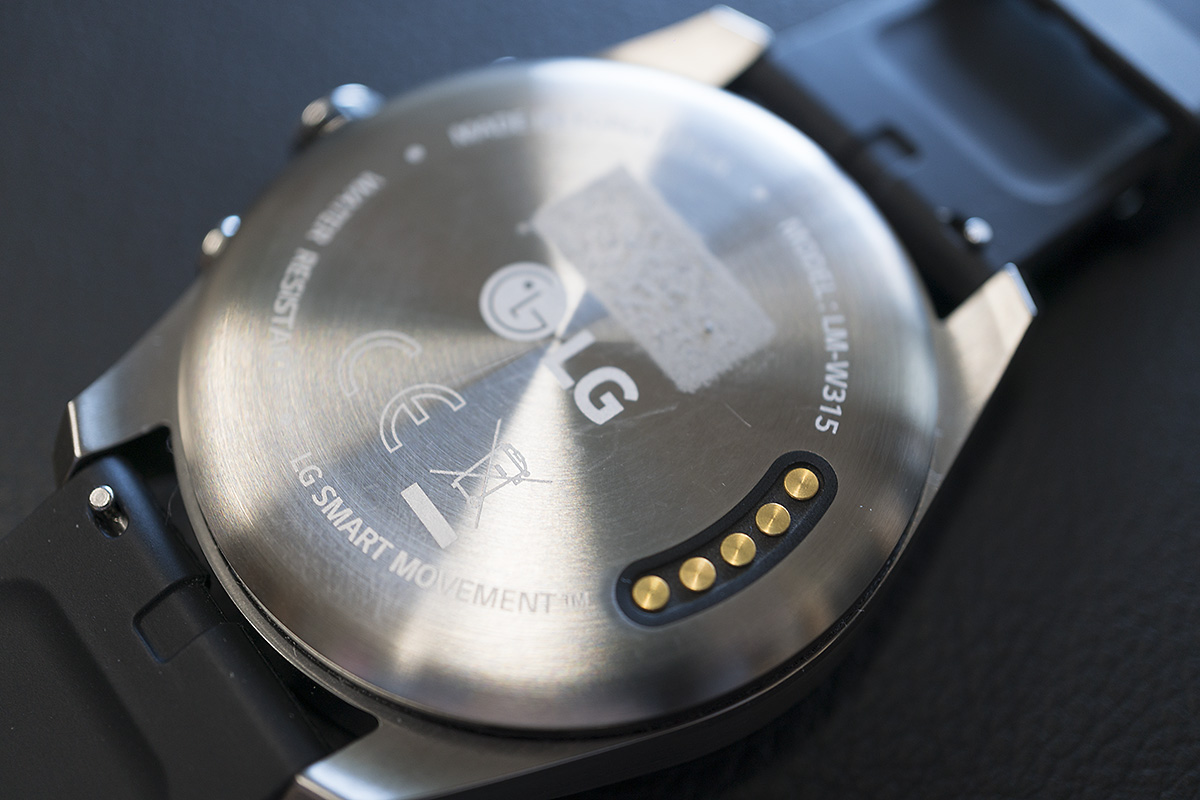
The bottom of LG Watch W7. There is no heart rate sensor and only contacts for charging remain. When I removed the product inventory sticker, it was unfortunate that the adhesive remained in place.
The battery | A too fatal ending
The fatal problem lies in the battery life. This is not a level to be put up with. If I charge the watch in the morning and come back in the evening, barely 40% of battery life is left. If the watch is not charged, the W7 will not be able to demonstrate its abilities as a smartwatch.
Only a day at the longest. I wondered very shortly whether it was a problem of a watch currently being tested. But same comments from foreign reviews about the LG Watch W7 confirmed that it was not the problems of the product that I tested. In spite of desperately emphasizing its features as a watch by leaving out the heart rate sensor, the GPS and the NFC, why wasn’t LG able to fill the watch with the virtue of ‘persistence’ that should be included in a device that runs on battery? Who made the misjudgment that the old Snapdragon Wear 2100 processor and a battery capacity of only 240mAh would suffice for a smartwatch to last days?
The watch will work even if the battery is all used up. Even after the battery gets very low to the extent that the display cannot be turned on, the W7 will rotate its long minute hand using the last amount of energy that is left. For up to three days, the watch seems to be accomplishing its mission by keeping its last pride as a watch with hands. However, I can’t make compliments about this pitiful situation in which a watch keeps working without being able to use its abilities as a smartwatch. Without any hesitation, I would recommend skipping the first generation. But I am also not sure whether there will be a second generation at all.
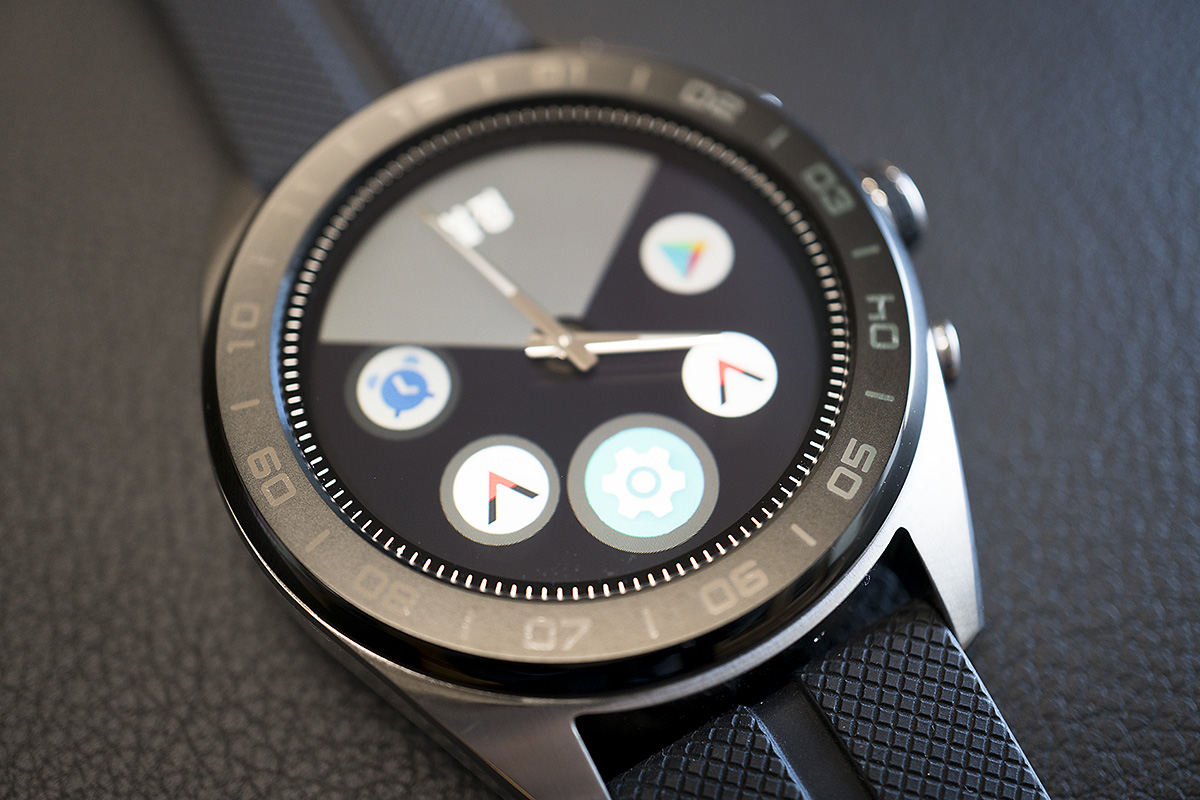
STRENGTHS
- Time can be checked even after the display is turned off
- The watch function will work for additional days even after the battery dies
WEAKNESSES
- An excessively short battery life in the display mode
- Watch hands that are not too exposed
- Confusing interface
- Pricey compared to the value felt by users
- More disadvantages than advantages



